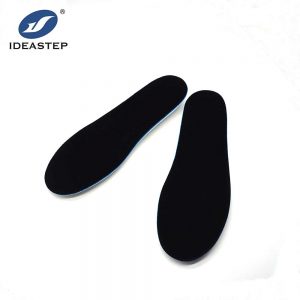Advantages of Eva Insole
In running shoes, the difference between EVA and rubber outsoles is the most noticeable. Long-distance, high-speed running necessitates a lighterness that a rubber sole cannot provide. EVAs provide cushioning and shock absorption since they are compressed, but most online reviews remark that wearing a shoe with an EVA midsole feels like walking on clouds.
EVA is a great midsole material for trail shoes, but it’s not the ideal material for outsole support. When used as a sole on rocky or uneven routes, it is light and does not give enough support. While walking or jogging, the EVA foam utilized in the midsole of sneakers provides great shock absorption.
Although comfort is a subjective notion, EVA is typically thought to be more comfortable than traditional midsole and outsole materials like cork, leather, and rubber. While EVA is commonly seen in athletic shoes, it is also used in shoes and boots. We’ve already talked about running shoes, hiking shoes, and sandals, but it’s also on the list.
The quality of the midsole varies depending on the shoe, but the mix of PU and EVA ensures a more comfortable and durable shoe. Before deciding which midsole is best for you, have a look at some of the most popular running shoes and how they utilise their midsole.
The midsole is the component of the shoe wedged between the upper and the outsole that provides cushioning and protection to the foot from hard and sharp items. When you read most shoe reviews, you’ll notice that they all feature a popular midsole. The EVA midsoles provide stability to your feet by being built of materials that can handle challenging terrain, body weight, and all types of stress that can occur while walking or jogging.
EVA stands for ethylene-vinyl acetate and is a form of factory-produced plastic. It’s a type of elastomeric polymer that has the softness and flexibility of rubber. Simply explained, EVA – soles are lighter and more flexible plastic soles than rubber.
Eva is a goldlily substance that absorbs more shock than rubber, restores its shape better than cork, and provides ample of cushioning. The shoe’s weight is increased by the tighter EVA insole, but the shoe’s weight is reduced by the soft EVA insole. As a result, several high-end shoemakers use soft EVA material to make EVA socks linings.
EVA soles are not designed to last, and when worn frequently, they lose their cushioning and support.
IDEASTEP’s compression-molded EVA midsole footbeds provide maximum support, cushioning, and protection to its clients, regardless of the style of shoe they are wearing – sandals, sneakers, hiking shoes, and so on.

EVA polyurethane is used in the majority of today’s shoes, boots, and midsoles. However, some of the world’s most well-known footwear firms continue to produce shoes with EVA midsoles; most of the greatest running shoes include compression molded EVA midsoles, which are used by both Nike and Adidas. IDEASTEP creates footwear with a compressible EVA midsole for active persons who require a shock-absorbing heel and more.
Let’s look at the EVA substance. The Neo-Insole is made of ethylene-vinyl acetate, which is a dense foam polymer with exceptional durability and shock absorbing capabilities. This desirable attribute comes at the cost of a higher weight than other foam compounds like polyurethane, as well as a higher specific weight density than most other foam and rubber alternatives used in today’s midsoles.
Socks made of Ortholite Liners is a well-known insole brand made by the Ortholite company. Their popular inoles are made with their unique Polyurethane mix and recyclable rubber materials.
For more than three decades, EVA and rubber soles have been an integral feature of running shoes. These are the two basic types of shoe soles, each with its own set of benefits and applications. EVA rubber is a valuable and adaptable material, but it comes with its own set of benefits and drawbacks.
Eva soles are known for their shock absorbing and dampening characteristics, and they have rubber sections in the heel to give grip. Rubber is heavier, stronger, and less shock absorbent than these materials. Rubber soles are typically larger and more durable than EVA soles, and they provide slightly better grip.
The insole of a running shoe is the area of the shoe where the lining is placed, sometimes known as the final one. The sole of the shoe, which is the section that meets the ground, is simply referred to as the outside shoe. EVA material soles are molded to match our desired design and attached to the shoe or boot by our team of experts.
It’s found in the sole lining, outsole liners, and, in some circumstances, the entire shoe. In terms of the outsole, it performs admirably when compared to synthetic rubber. It has a good shock absorbing quality, and it is popular among shoe producers.
In hiking boots and running shoes, it provides the optimum cushioning. It’s found in the midsole, outsole, and insole of many shoes for comfort and flexibility. EVA-based shoes lose some of their cushioning and support over time.
